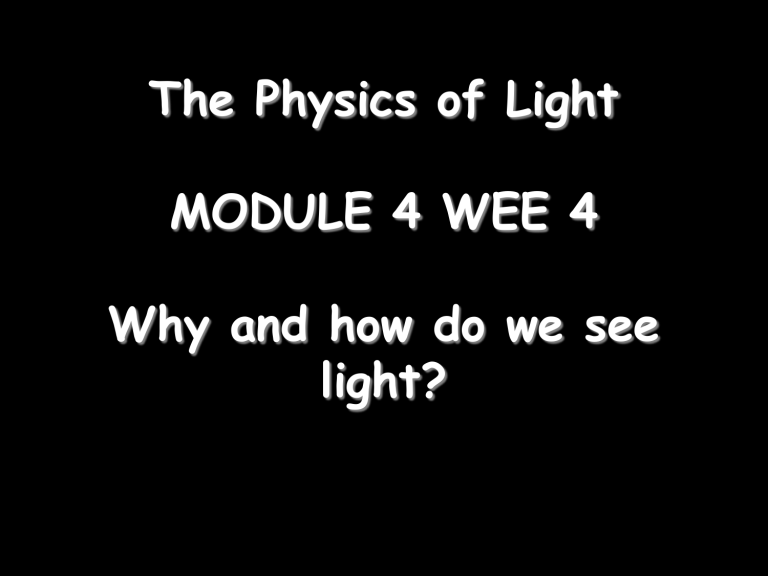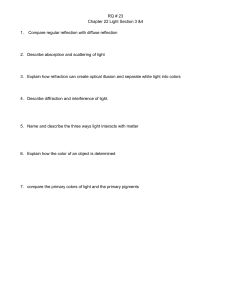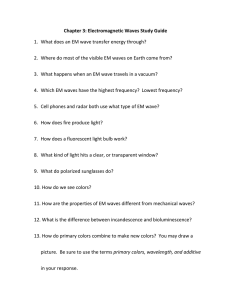
The Physics of Light MODULE 4 WEE 4 Why and how do we see light? What Is Light? In this Powerpoint presentation: 1) 2) 3) 4) Properties of light Colors Reflection - Mirrors Refraction - Lenses Properties of Light Light travels in straight lines: Laser Light travels much faster than sound. For example: 1) Thunder and lightning start at the same time, but we will see the lightning first. 2) When a starting pistol is fired we see the smoke first and then hear the bang. Light travels VERY FAST – about 300,000 kilometers per second or 186,000 miles per second. At this speed light could travel the equivalent of 8 times around the world in one second! Light can create shadows Shadows are places where light is “blocked”: Rays of light Light travels in waves A wave is a disturbance that transfers energy from place to place. What characteristics do light waves have? Light waves are like other kinds of waves. They have crests, troughs, wavelength, frequency and speed. However, light waves are electromagnetic! Light waves have a component that is electric and magnetic!! We see things because they reflect light into our eyes! This is literally the only way we get to see things! ALL objects we see either create light or reflect light!! Homework Electromagnetic Radiation •Light is a form of energy called Electromagnetic Radiation Electromagnetic Radiation comes from the sun and other sources •Travels at the speed of light •Is mostly invisible •Carries energy •Is VERY important to society and is something YOU can’t be without for many reasons Properties of Light summary 1) Light travels in straight lines and is a form of energy 2) Light travels much faster (a million times faster!) than sound 3) We see things because they reflect light into our eyes 4) Shadows are formed when light is blocked by an object 5) Visible light is only a small part of the electromagnetic spectrum; the other parts are invisible to the human eye but not necessarily the eyes of other animals. Part 2 - Reflection and Mirrors Regular vs. Diffuse Reflection Smooth, shiny surfaces have a regular reflection: Rough, dull surfaces have a diffuse reflection. Diffuse reflection is when light is scattered in different directions Using mirrors Two examples: 2) A car headlight 1) A periscope Types of Mirrors: Plane, Concave, Convex Plane mirrors are flat and make “virtual images”. The images is “virtual” because the light rays do not come from the image, they only appear to Concave Mirrors are curved inward - just remember, you go “in” to a cave, and “in” to a concave mirror! Convex mirrors are mirrors that curve outward Convex mirrors are used for security purposes, in cars etc. They allow us to see a wide view. The images they make are virtual Review of Reflection 1. Two types of reflection, regular and diffuse 2. Mirrors come in 3 types: plane, convex and concave. Each has a distinct shape and use. 3. Mirrors can make virtual images or real images depending on their type 4. Virtual images - light rays do not meet and the image is always upright or right-side-up 5. Real images - always upside down and are formed when light rays actually meet Refraction •Refraction is when waves speed up or slow down due to travelling in a different medium •A medium is something that light waves will travel through •Light rays are slowed down by the water •Causes the ruler to look bent at the surface • The mediums in this example are water and air The degree that light bends when it enters a new medium is called the “index of refraction” Light hitting at an angle is bent Light hitting straight on is not bent Lenses work because of refraction! Light is bent as it enters a new medium, glass! 1. Thicker in middle, thin on edges 2. Light rays meet to form a focal point 3. Makes real images since light rays come together from a light source, but can also make virtual images (center picture) 4. Used in cameras, telescopes, human eye Concave Lenses 1. Concave lenses are thin in the middle and thicker on the edges 2. Since light rays never meet with this lens, they make virtual images only 3. Used in cameras & telescopes to correct spherical aberation, and also eyeglasses Review of Refraction 1. Light rays slow down when they enter a new medium 2. Refraction can cause light rays to change their direction 3. All transparent materials have their own “index of refraction” 4. Light is refracted when it passes through lenses and this creates images Color Part 3 - Color In this section of the Powerpoint you will learn about color and how we can mix colors to create other colors. We will also learn how light helps us to see various colors around us. Color White light is not a single color; it is made up of a mixture of the seven colors of the rainbow. We can demonstrate this by splitting white light with a prism: This is how rainbows are formed: sunlight is “split up” by raindrops. The colors of the rainbow: Just remember ROY G. BIV Red Orange Yellow Green Blue Indigo Violet Adding colors of light White light can be split up to make separate colors. These colors can be added together again. The primary colors of light are red, blue and green: Adding blue and red makes magenta (purple) Adding red and green makes yellow Adding blue and green makes cyan (light blue) Adding all three makes white again Seeing color The color an object appears depends on the colors of light it reflects. For example, a red book only reflects red light: White light Only red light is reflected In different colors of light this shirt would look different: Red light Shirt looks red Shorts look black Shirt looks black Blue light Shorts look blue A pair of purple trousers would reflect purple light (and red and blue, as purple is made up of red and blue): Purple light A white hat would reflect all seven colors: White light Using filters Filters can be used to “block” out different colours of light: Red Filter Magenta Filter Some further examples: Object Red socks Blue teddy Color of light Color object seems to be Red Red Blue Black Green Black Red Black Blue Green Red Green camel Blue Green Red Magenta book Blue Green Investigating filters Color of filter Red Green Blue Cyan Magenta Yellow Colors that could be “seen” Red Blue Green Yellow Cyan Magenta White Part 2 - Reflection and Mirrors Reflection from a mirror: Normal Reflected ray Incident ray Angle of incidence Angle of reflection Mirror The Law of Reflection Angle of incidence = Angle of reflection In other words, light gets reflected from a surface at ____ _____ angle it hits it. The same !!! How do haloes, sundogs, primary rainbows, secondary rainbows, and supernumerary bows occur? Haloes Solar halo, which is also called gloriole, icebow or nimbus, is a light phenomenon that happens when light shines through clouds that are composed of ice crystals. Light refracts upon passing through the ice crystals and also reflects upon hitting the crystal’s faces; these events cause the formation of the bright ring around the Sun or Moon. Halo is usually bright white ring but may also have colors due to the dispersion of light upon striking the ice crystals. Below is a picture of a halo produced around the Sun. How do haloes, sundogs, primary rainbows, secondary rainbows, and supernumerary bows occur? Sundogs Sundogs, or parhelion (with the sun), happen due to the refraction of light upon hitting the small crystals that make up cirrus or cirrostratus clouds. These crystals are hexagonal in shape and with faces almost horizontal upon drifting; these cause the formation of spots of light (sundog) on either side of the Sun, or the Moon, when light strikes them at a minimum angle of 22 degrees as shown in the image below. Since red light is the least refracted compared to blue this makes the inner edge of a sundog to be red hued. The image below shows an actual sundog which has a red-hued inner edge. How do haloes, sundogs, primary rainbows, secondary rainbows, and supernumerary bows occur? Rainbows A rainbow is a light phenomenon formed from the combination of several light properties like refraction, reflection, and dispersion. Rainbows are usually seen after rainfall because they are formed when light strikes the scattered raindrops in the atmosphere. As shown in the image below, light is refracted upon hitting a raindrop that serves as the prism. Due to the differences in the frequency of the colors of visible light, they are refracted at different amounts and are dispersed. The dispersed colors reflect upon hitting the other side of the raindrop and then refracted again as they go out. The colors go out dispersed and reach the observer’s eyes. Why clouds are usually white and rainclouds dark Rain Cloud White is how our eyes perceive all wavelengths of sunlight mixed together. When it's about to rain, clouds darken because the water vapor is clumping together into raindrops, leaving larger spaces between drops of water. Less light is reflected. The rain cloud appears black or gray. Why is the sky blue? Why are sunsets red? Blue and Red Take a look at light through a prism and notice all the different colors that you can see. Light that looks white to our eyes actually is made up of many different colors. Each color can be thought of as a light wave with a different wavelength (or size). Within the small range of wavelengths (or colors) that we can see with our eyes, the shorter waves are blue and the longer ones are red. Colors such as green, yellow, and orange lie in between the blue and red ends of the visible spectrum. Why is the sky blue? Why are sunsets red? Blue and Red When light comes from the sun, all these light waves of different wavelengths travel through empty space. When they reach Earth’s atmosphere, the light waves can interact with particles in the air like dust, water droplets, and ice crystals. Because of the extremely small size of visible light waves (less than one millionth of a meter), these light waves also interact the tiny gas molecules that make up the air itself. The light waves bounce off these particles just like you might bounce and get jostled in a busy hallway. As the light waves bounce in lots of different directions, we say they have been scattered. Why is the sky blue? Why are sunsets red? Blue Sky How light waves get scattered depends strongly on the size of the particle compared with the wavelength of the light. Particles that are small compared with the light wavelength scatter blue light more strongly than red light. Because of this, the tiny gas molecules that make up our Earth’s atmosphere (mostly oxygen and nitrogen) scatter the blue portion of sunlight in all directions, creating an effect that we see as a blue sky. Why is the sky blue? Why are sunsets red? Blue Sky Within the visible range of light, red light waves are scattered the least by atmospheric gas molecules. So at sunrise and sunset, when the sunlight travels a long path through the atmosphere to reach our eyes, the blue light has been mostly removed, leaving mostly red and yellow light remaining. The result is that the sunlight takes on an orange or red cast, which we can see reflected from clouds or other objects as a colorful sunset (or sunrise). Why is the sky blue? Why are sunsets red? Small particles of dust and pollution in the air can contribute to (and sometimes even enhance) these colors, but the primary cause of a blue sky and orange/red sunsets or sunrises is scattering by the gas molecules that make up our atmosphere. Large particles of pollution or dust scatter light in a way that changes much less for different colors. The result is that a dusty or polluted sky is usually more grayish white than blue. Similarly, cloud droplets (typically 10 millionths to 100 millionths of a meter) are much larger than visible light waves, so they scatter light without much color variation. This is why light scattered by clouds takes on the same color as the incoming light. For example, clouds will appear white or gray at midday and orange or red at sunrise or sunset. In this way, clouds act as a screen on which nature’s colors are painted. This is why sunsets or sunrises are so much prettier when some clouds are available to show us the colors.



